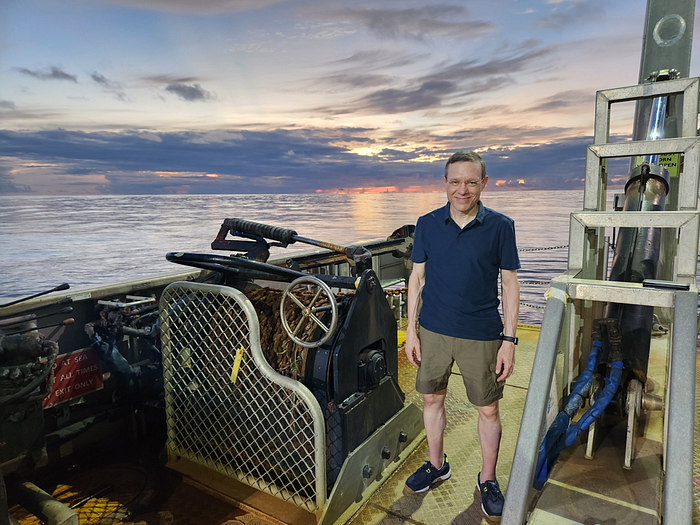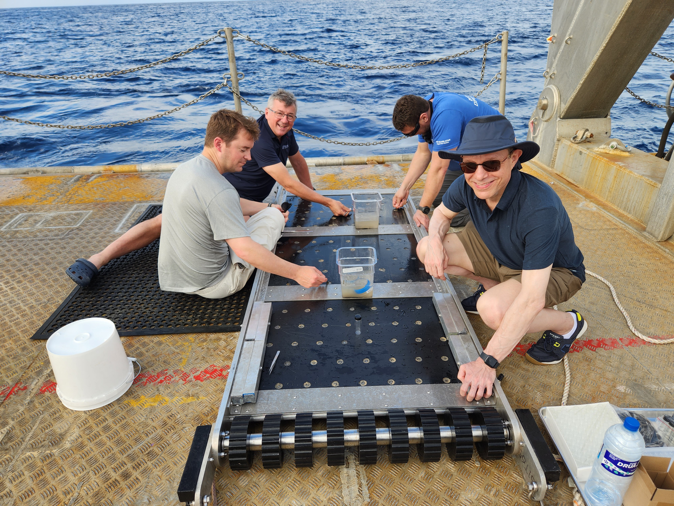Diary of an Interstellar Voyage: Part 12 (June 18, 2023)

After a sleepless night, I went out to Silver Star’s deck for a beautiful sunrise in anticipation of Run 5 along the second half of the most likely path of the first recognized interstellar meteor, IM1. The harvest was as rich as Run 4's, with multiple wires, flat fragments and even a bent human-made brad nail.






In Run 4, the sled bumped into a paint bucket on the ocean floor. I took a sample of the paint and asked Ryan Weed to check whether it has lead, labeled Pb in the periodic table of elements. White is a common color used on US Navy ships and in 1978 the use of lead in paint was banned by law. If the paint bucket was dropped from a US Navy ship nearing Japan during World War II, we would find Pb in our X-ray fluorescence analyzer.
We can estimate to within an order of magnitude the number of nails and paint buckets per square kilometer of the ocean floor at this location. The combined survey area of Runs 4 and 5 was twice the width of the sled — roughly half a meter, times the length of the line being surveyed — roughly 10 kilometers. This gives a percent of a square kilometer, implying that there should be about a hundred nails or paint buckets per square kilometer on the ocean floor at this location. Whereas this number sounds reasonable for nails, it is far bigger than I expected for Navy paint buckets. If true, it means that Navy personnel were particularly careless about the environment and contaminated the ocean with plenty of trash. Anyone contaminating a busy street in Manhattan with a hundred paint buckets per square kilometer would have been jailed for public mischief and vandalism by the New York City police. Shoving this much trash under a mile-deep body of water is equivalent to hiding dirt under the carpet.
The key question for today’s analysis is whether the wires or flat fragments that were recovered in Run 4 & 5 were all made by humans or perhaps some were delivered by IM1 as the product of an extraterrestrial technological civilization.
We have recovered hundreds of grams of materials from Runs 4 & 5. They will enable a thorough calibration of the background and an analysis of the composition and abundances of radioactive elements in outliers.
In contrast to Navy trash, interstellar trash is our treasure. We would never jail our interstellar neighbors for public mischief and vandalism. Instead, we might be inspired to send our own space probes to their backyard.
ABOUT THE AUTHOR

Avi Loeb is the head of the Galileo Project, founding director of Harvard University’s — Black Hole Initiative, director of the Institute for Theory and Computation at the Harvard-Smithsonian Center for Astrophysics, and the former chair of the astronomy department at Harvard University (2011–2020). He chairs the advisory board for the Breakthrough Starshot project, and is a former member of the President’s Council of Advisors on Science and Technology and a former chair of the Board on Physics and Astronomy of the National Academies. He is the bestselling author of “Extraterrestrial: The First Sign of Intelligent Life Beyond Earth” and a co-author of the textbook “Life in the Cosmos”, both published in 2021. His new book, titled “Interstellar”, is scheduled for publication in August 2023.
